Activities Report: Self-Awareness and Emotional Intelligence Workshop
VerifiedAdded on 2022/09/01
|7
|1818
|14
Report
AI Summary
This report details a professional development workshop focused on self-awareness and emotional intelligence, comprising three key activities. The first activity utilizes the Johari Window model to enhance self-awareness by exploring open, blind, hidden, and unknown aspects of oneself. The second activity concentrates on presentation skills, emphasizing the importance of confidence, communication, and reflective practice for effective presentations. The third activity delves into emotional intelligence, exploring the impact of various emotions in the workplace and promoting strategies for managing them, including anger, joy, fear, hope, sorrow, and surprise. The workshop aims to improve soft skills, manage conflicts, and foster better relationships within the workplace, with a focus on the benefits of emotional intelligence and self-regulation. The report emphasizes the significance of these activities for both personal and professional growth, providing a comprehensive overview of their objectives and methodologies.
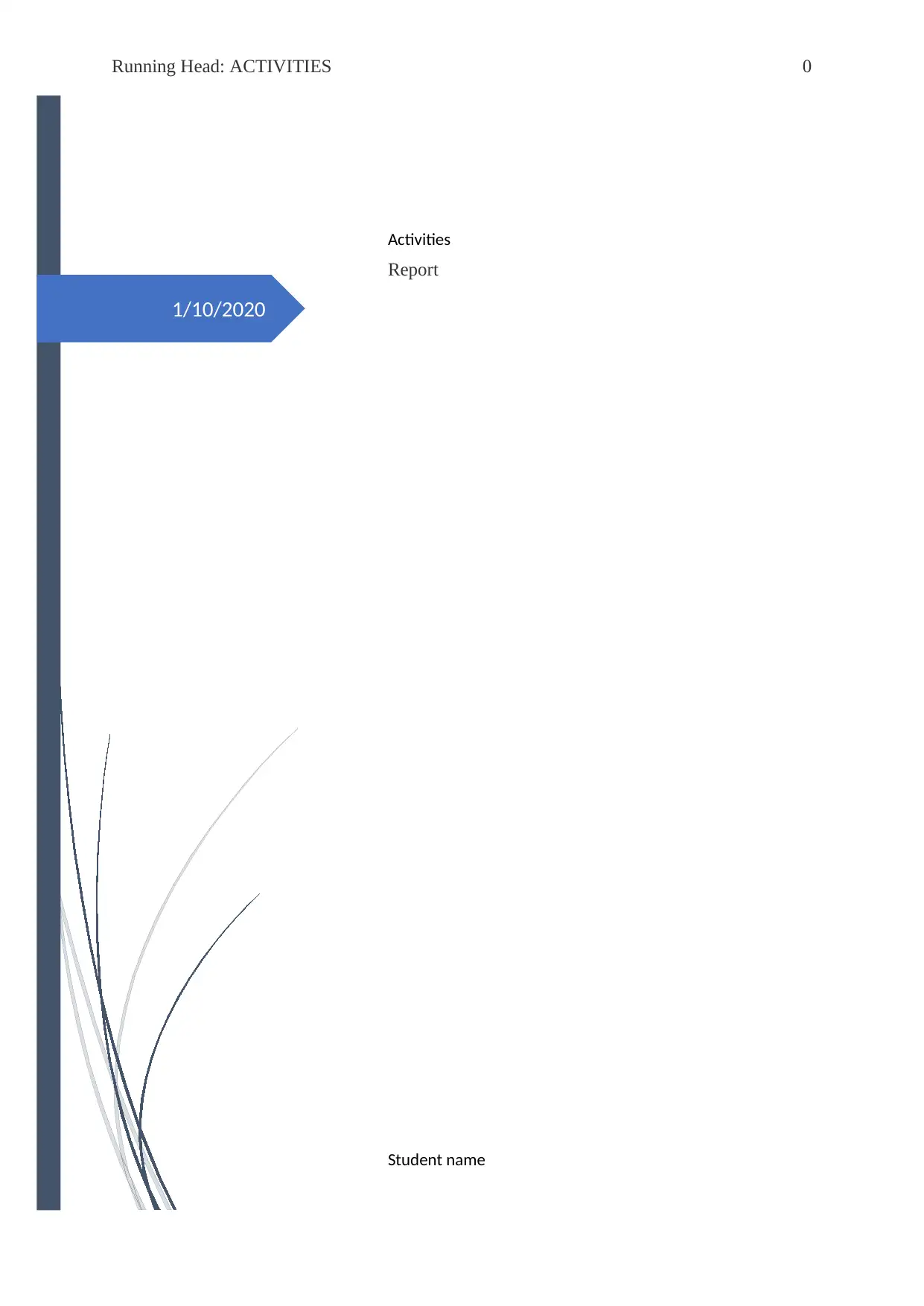
1/10/2020
Running Head: ACTIVITIES 0
Activities
Report
Student name
Running Head: ACTIVITIES 0
Activities
Report
Student name
Paraphrase This Document
Need a fresh take? Get an instant paraphrase of this document with our AI Paraphraser
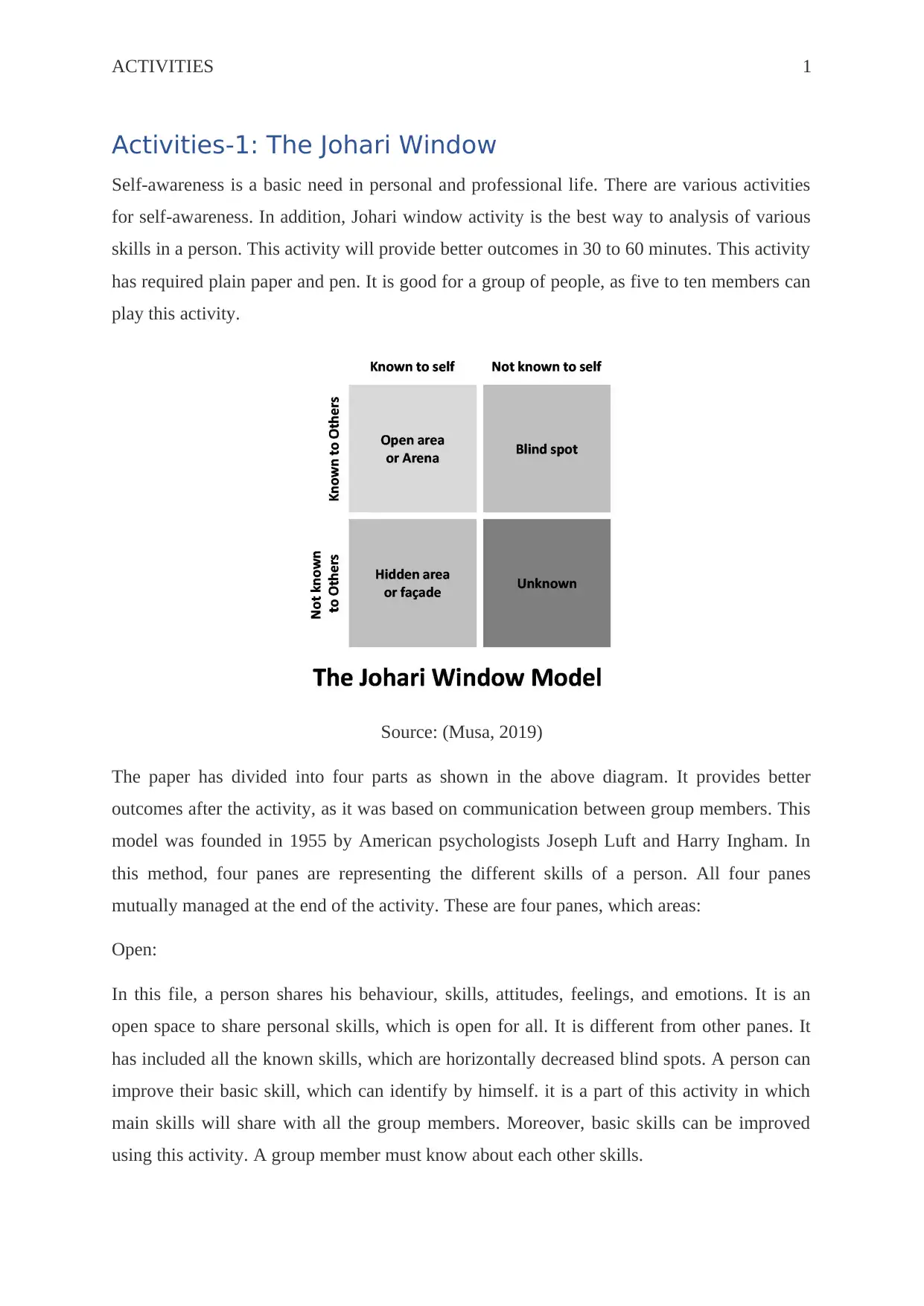
ACTIVITIES 1
Activities-1: The Johari Window
Self-awareness is a basic need in personal and professional life. There are various activities
for self-awareness. In addition, Johari window activity is the best way to analysis of various
skills in a person. This activity will provide better outcomes in 30 to 60 minutes. This activity
has required plain paper and pen. It is good for a group of people, as five to ten members can
play this activity.
Source: (Musa, 2019)
The paper has divided into four parts as shown in the above diagram. It provides better
outcomes after the activity, as it was based on communication between group members. This
model was founded in 1955 by American psychologists Joseph Luft and Harry Ingham. In
this method, four panes are representing the different skills of a person. All four panes
mutually managed at the end of the activity. These are four panes, which areas:
Open:
In this file, a person shares his behaviour, skills, attitudes, feelings, and emotions. It is an
open space to share personal skills, which is open for all. It is different from other panes. It
has included all the known skills, which are horizontally decreased blind spots. A person can
improve their basic skill, which can identify by himself. it is a part of this activity in which
main skills will share with all the group members. Moreover, basic skills can be improved
using this activity. A group member must know about each other skills.
Activities-1: The Johari Window
Self-awareness is a basic need in personal and professional life. There are various activities
for self-awareness. In addition, Johari window activity is the best way to analysis of various
skills in a person. This activity will provide better outcomes in 30 to 60 minutes. This activity
has required plain paper and pen. It is good for a group of people, as five to ten members can
play this activity.
Source: (Musa, 2019)
The paper has divided into four parts as shown in the above diagram. It provides better
outcomes after the activity, as it was based on communication between group members. This
model was founded in 1955 by American psychologists Joseph Luft and Harry Ingham. In
this method, four panes are representing the different skills of a person. All four panes
mutually managed at the end of the activity. These are four panes, which areas:
Open:
In this file, a person shares his behaviour, skills, attitudes, feelings, and emotions. It is an
open space to share personal skills, which is open for all. It is different from other panes. It
has included all the known skills, which are horizontally decreased blind spots. A person can
improve their basic skill, which can identify by himself. it is a part of this activity in which
main skills will share with all the group members. Moreover, basic skills can be improved
using this activity. A group member must know about each other skills.
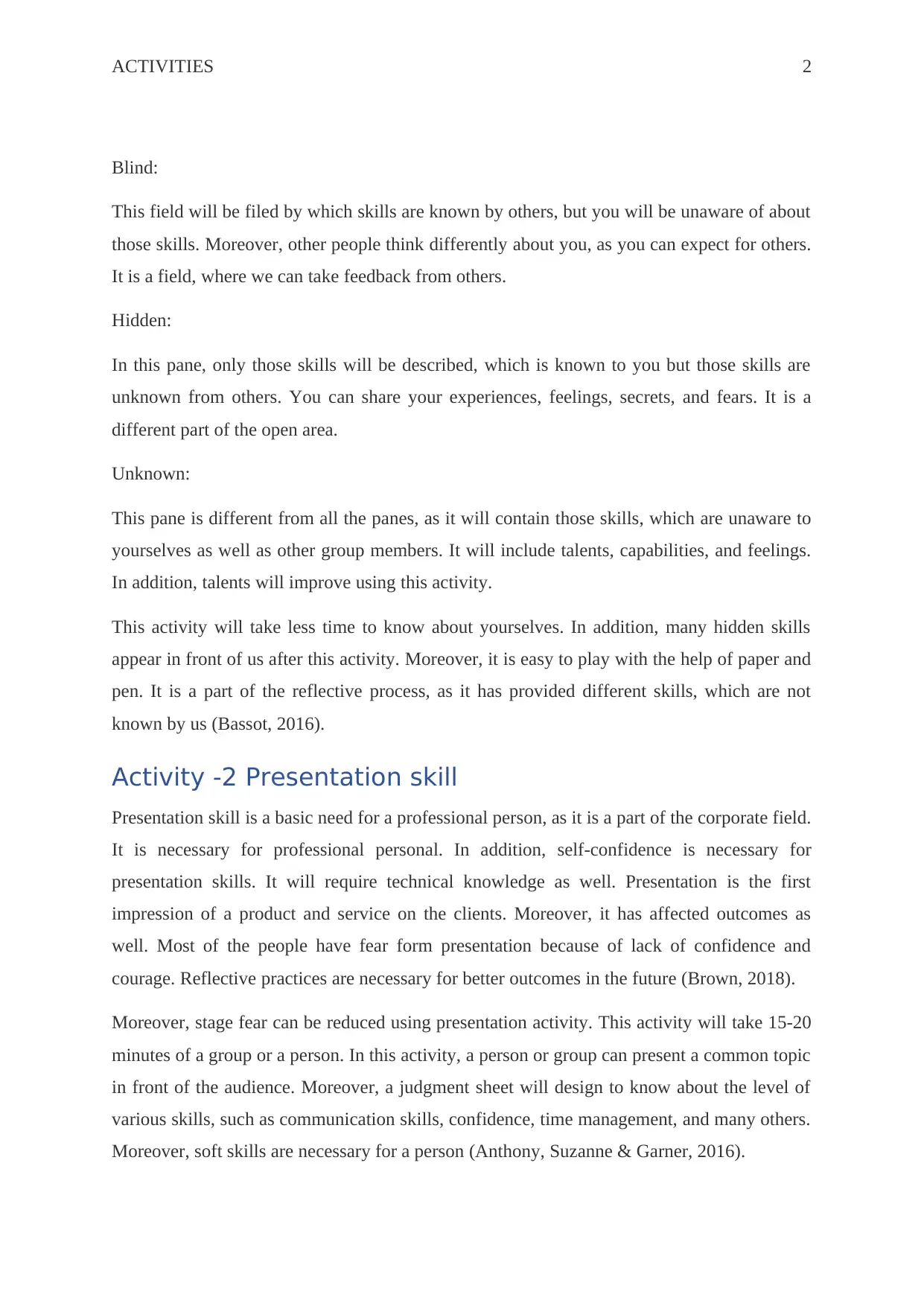
ACTIVITIES 2
Blind:
This field will be filed by which skills are known by others, but you will be unaware of about
those skills. Moreover, other people think differently about you, as you can expect for others.
It is a field, where we can take feedback from others.
Hidden:
In this pane, only those skills will be described, which is known to you but those skills are
unknown from others. You can share your experiences, feelings, secrets, and fears. It is a
different part of the open area.
Unknown:
This pane is different from all the panes, as it will contain those skills, which are unaware to
yourselves as well as other group members. It will include talents, capabilities, and feelings.
In addition, talents will improve using this activity.
This activity will take less time to know about yourselves. In addition, many hidden skills
appear in front of us after this activity. Moreover, it is easy to play with the help of paper and
pen. It is a part of the reflective process, as it has provided different skills, which are not
known by us (Bassot, 2016).
Activity -2 Presentation skill
Presentation skill is a basic need for a professional person, as it is a part of the corporate field.
It is necessary for professional personal. In addition, self-confidence is necessary for
presentation skills. It will require technical knowledge as well. Presentation is the first
impression of a product and service on the clients. Moreover, it has affected outcomes as
well. Most of the people have fear form presentation because of lack of confidence and
courage. Reflective practices are necessary for better outcomes in the future (Brown, 2018).
Moreover, stage fear can be reduced using presentation activity. This activity will take 15-20
minutes of a group or a person. In this activity, a person or group can present a common topic
in front of the audience. Moreover, a judgment sheet will design to know about the level of
various skills, such as communication skills, confidence, time management, and many others.
Moreover, soft skills are necessary for a person (Anthony, Suzanne & Garner, 2016).
Blind:
This field will be filed by which skills are known by others, but you will be unaware of about
those skills. Moreover, other people think differently about you, as you can expect for others.
It is a field, where we can take feedback from others.
Hidden:
In this pane, only those skills will be described, which is known to you but those skills are
unknown from others. You can share your experiences, feelings, secrets, and fears. It is a
different part of the open area.
Unknown:
This pane is different from all the panes, as it will contain those skills, which are unaware to
yourselves as well as other group members. It will include talents, capabilities, and feelings.
In addition, talents will improve using this activity.
This activity will take less time to know about yourselves. In addition, many hidden skills
appear in front of us after this activity. Moreover, it is easy to play with the help of paper and
pen. It is a part of the reflective process, as it has provided different skills, which are not
known by us (Bassot, 2016).
Activity -2 Presentation skill
Presentation skill is a basic need for a professional person, as it is a part of the corporate field.
It is necessary for professional personal. In addition, self-confidence is necessary for
presentation skills. It will require technical knowledge as well. Presentation is the first
impression of a product and service on the clients. Moreover, it has affected outcomes as
well. Most of the people have fear form presentation because of lack of confidence and
courage. Reflective practices are necessary for better outcomes in the future (Brown, 2018).
Moreover, stage fear can be reduced using presentation activity. This activity will take 15-20
minutes of a group or a person. In this activity, a person or group can present a common topic
in front of the audience. Moreover, a judgment sheet will design to know about the level of
various skills, such as communication skills, confidence, time management, and many others.
Moreover, soft skills are necessary for a person (Anthony, Suzanne & Garner, 2016).
⊘ This is a preview!⊘
Do you want full access?
Subscribe today to unlock all pages.

Trusted by 1+ million students worldwide
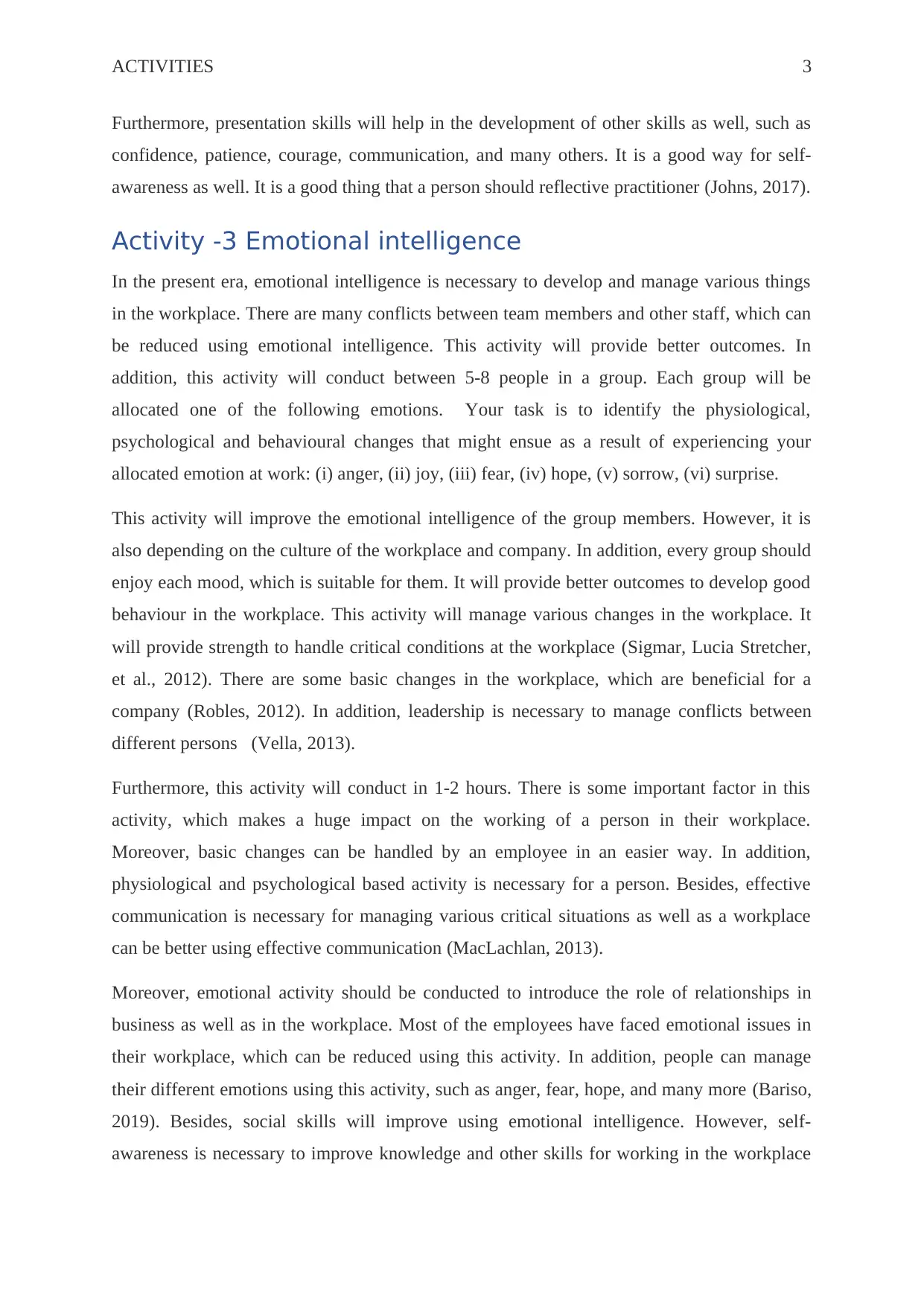
ACTIVITIES 3
Furthermore, presentation skills will help in the development of other skills as well, such as
confidence, patience, courage, communication, and many others. It is a good way for self-
awareness as well. It is a good thing that a person should reflective practitioner (Johns, 2017).
Activity -3 Emotional intelligence
In the present era, emotional intelligence is necessary to develop and manage various things
in the workplace. There are many conflicts between team members and other staff, which can
be reduced using emotional intelligence. This activity will provide better outcomes. In
addition, this activity will conduct between 5-8 people in a group. Each group will be
allocated one of the following emotions. Your task is to identify the physiological,
psychological and behavioural changes that might ensue as a result of experiencing your
allocated emotion at work: (i) anger, (ii) joy, (iii) fear, (iv) hope, (v) sorrow, (vi) surprise.
This activity will improve the emotional intelligence of the group members. However, it is
also depending on the culture of the workplace and company. In addition, every group should
enjoy each mood, which is suitable for them. It will provide better outcomes to develop good
behaviour in the workplace. This activity will manage various changes in the workplace. It
will provide strength to handle critical conditions at the workplace (Sigmar, Lucia Stretcher,
et al., 2012). There are some basic changes in the workplace, which are beneficial for a
company (Robles, 2012). In addition, leadership is necessary to manage conflicts between
different persons (Vella, 2013).
Furthermore, this activity will conduct in 1-2 hours. There is some important factor in this
activity, which makes a huge impact on the working of a person in their workplace.
Moreover, basic changes can be handled by an employee in an easier way. In addition,
physiological and psychological based activity is necessary for a person. Besides, effective
communication is necessary for managing various critical situations as well as a workplace
can be better using effective communication (MacLachlan, 2013).
Moreover, emotional activity should be conducted to introduce the role of relationships in
business as well as in the workplace. Most of the employees have faced emotional issues in
their workplace, which can be reduced using this activity. In addition, people can manage
their different emotions using this activity, such as anger, fear, hope, and many more (Bariso,
2019). Besides, social skills will improve using emotional intelligence. However, self-
awareness is necessary to improve knowledge and other skills for working in the workplace
Furthermore, presentation skills will help in the development of other skills as well, such as
confidence, patience, courage, communication, and many others. It is a good way for self-
awareness as well. It is a good thing that a person should reflective practitioner (Johns, 2017).
Activity -3 Emotional intelligence
In the present era, emotional intelligence is necessary to develop and manage various things
in the workplace. There are many conflicts between team members and other staff, which can
be reduced using emotional intelligence. This activity will provide better outcomes. In
addition, this activity will conduct between 5-8 people in a group. Each group will be
allocated one of the following emotions. Your task is to identify the physiological,
psychological and behavioural changes that might ensue as a result of experiencing your
allocated emotion at work: (i) anger, (ii) joy, (iii) fear, (iv) hope, (v) sorrow, (vi) surprise.
This activity will improve the emotional intelligence of the group members. However, it is
also depending on the culture of the workplace and company. In addition, every group should
enjoy each mood, which is suitable for them. It will provide better outcomes to develop good
behaviour in the workplace. This activity will manage various changes in the workplace. It
will provide strength to handle critical conditions at the workplace (Sigmar, Lucia Stretcher,
et al., 2012). There are some basic changes in the workplace, which are beneficial for a
company (Robles, 2012). In addition, leadership is necessary to manage conflicts between
different persons (Vella, 2013).
Furthermore, this activity will conduct in 1-2 hours. There is some important factor in this
activity, which makes a huge impact on the working of a person in their workplace.
Moreover, basic changes can be handled by an employee in an easier way. In addition,
physiological and psychological based activity is necessary for a person. Besides, effective
communication is necessary for managing various critical situations as well as a workplace
can be better using effective communication (MacLachlan, 2013).
Moreover, emotional activity should be conducted to introduce the role of relationships in
business as well as in the workplace. Most of the employees have faced emotional issues in
their workplace, which can be reduced using this activity. In addition, people can manage
their different emotions using this activity, such as anger, fear, hope, and many more (Bariso,
2019). Besides, social skills will improve using emotional intelligence. However, self-
awareness is necessary to improve knowledge and other skills for working in the workplace
Paraphrase This Document
Need a fresh take? Get an instant paraphrase of this document with our AI Paraphraser
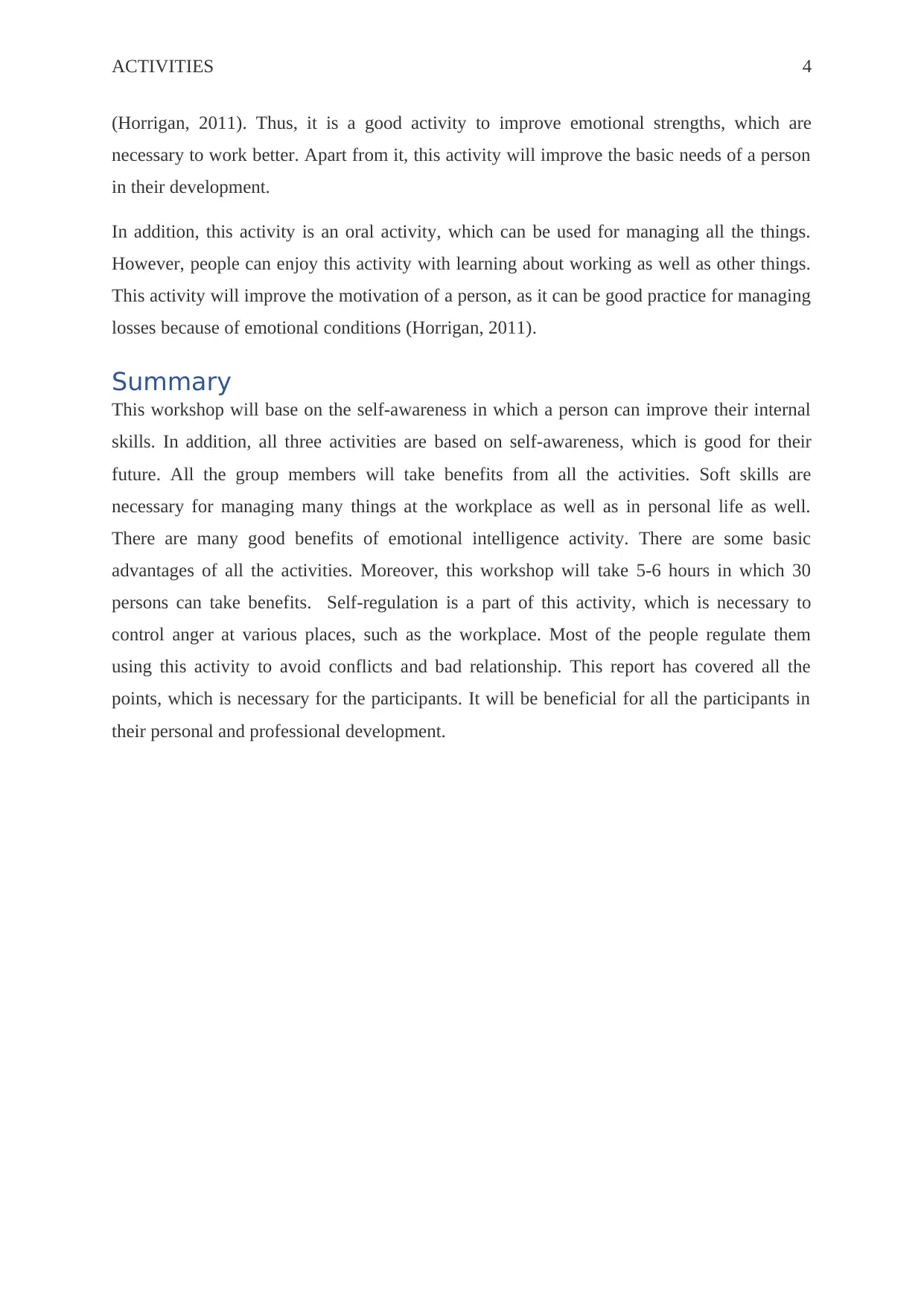
ACTIVITIES 4
(Horrigan, 2011). Thus, it is a good activity to improve emotional strengths, which are
necessary to work better. Apart from it, this activity will improve the basic needs of a person
in their development.
In addition, this activity is an oral activity, which can be used for managing all the things.
However, people can enjoy this activity with learning about working as well as other things.
This activity will improve the motivation of a person, as it can be good practice for managing
losses because of emotional conditions (Horrigan, 2011).
Summary
This workshop will base on the self-awareness in which a person can improve their internal
skills. In addition, all three activities are based on self-awareness, which is good for their
future. All the group members will take benefits from all the activities. Soft skills are
necessary for managing many things at the workplace as well as in personal life as well.
There are many good benefits of emotional intelligence activity. There are some basic
advantages of all the activities. Moreover, this workshop will take 5-6 hours in which 30
persons can take benefits. Self-regulation is a part of this activity, which is necessary to
control anger at various places, such as the workplace. Most of the people regulate them
using this activity to avoid conflicts and bad relationship. This report has covered all the
points, which is necessary for the participants. It will be beneficial for all the participants in
their personal and professional development.
(Horrigan, 2011). Thus, it is a good activity to improve emotional strengths, which are
necessary to work better. Apart from it, this activity will improve the basic needs of a person
in their development.
In addition, this activity is an oral activity, which can be used for managing all the things.
However, people can enjoy this activity with learning about working as well as other things.
This activity will improve the motivation of a person, as it can be good practice for managing
losses because of emotional conditions (Horrigan, 2011).
Summary
This workshop will base on the self-awareness in which a person can improve their internal
skills. In addition, all three activities are based on self-awareness, which is good for their
future. All the group members will take benefits from all the activities. Soft skills are
necessary for managing many things at the workplace as well as in personal life as well.
There are many good benefits of emotional intelligence activity. There are some basic
advantages of all the activities. Moreover, this workshop will take 5-6 hours in which 30
persons can take benefits. Self-regulation is a part of this activity, which is necessary to
control anger at various places, such as the workplace. Most of the people regulate them
using this activity to avoid conflicts and bad relationship. This report has covered all the
points, which is necessary for the participants. It will be beneficial for all the participants in
their personal and professional development.
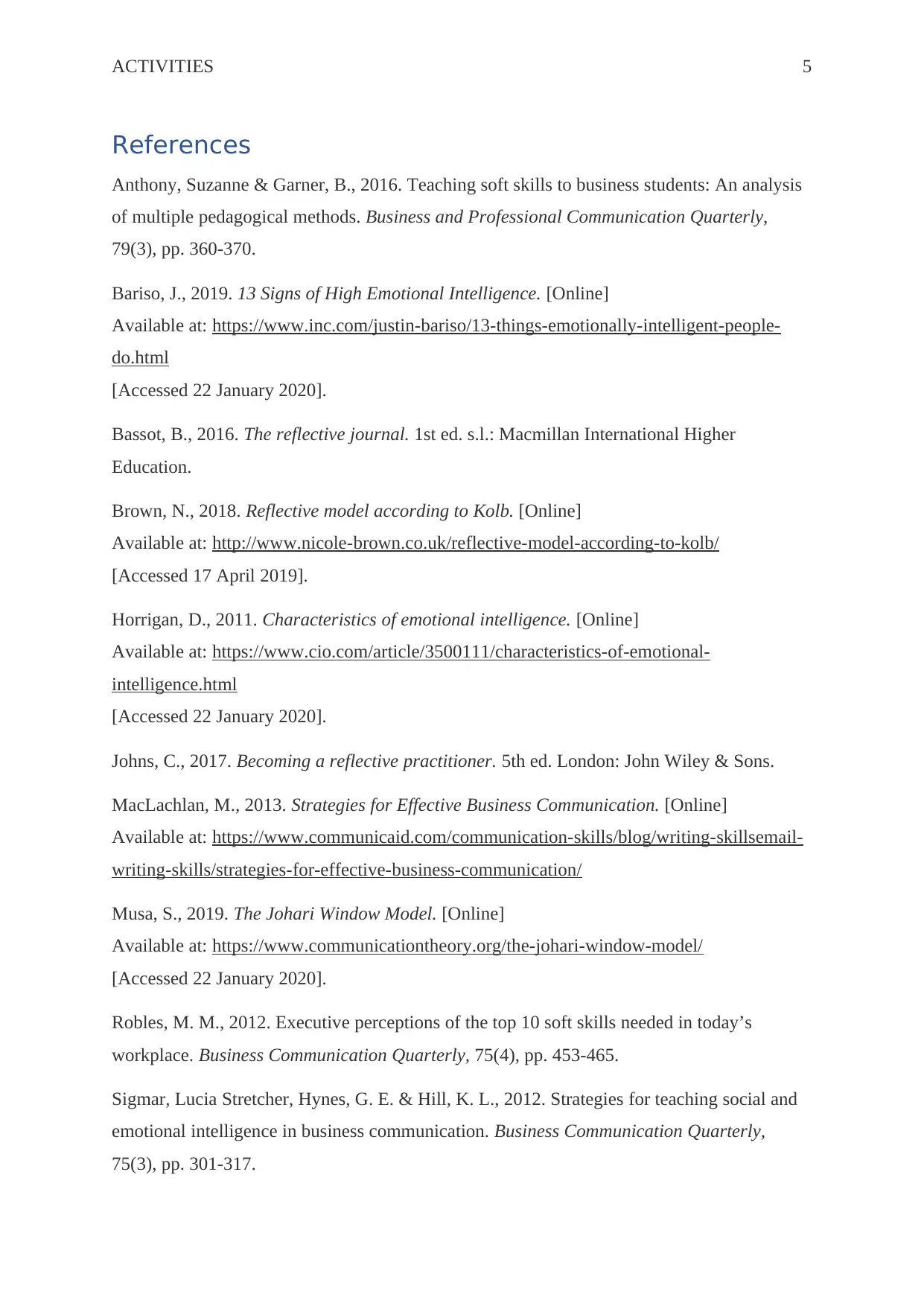
ACTIVITIES 5
References
Anthony, Suzanne & Garner, B., 2016. Teaching soft skills to business students: An analysis
of multiple pedagogical methods. Business and Professional Communication Quarterly,
79(3), pp. 360-370.
Bariso, J., 2019. 13 Signs of High Emotional Intelligence. [Online]
Available at: https://www.inc.com/justin-bariso/13-things-emotionally-intelligent-people-
do.html
[Accessed 22 January 2020].
Bassot, B., 2016. The reflective journal. 1st ed. s.l.: Macmillan International Higher
Education.
Brown, N., 2018. Reflective model according to Kolb. [Online]
Available at: http://www.nicole-brown.co.uk/reflective-model-according-to-kolb/
[Accessed 17 April 2019].
Horrigan, D., 2011. Characteristics of emotional intelligence. [Online]
Available at: https://www.cio.com/article/3500111/characteristics-of-emotional-
intelligence.html
[Accessed 22 January 2020].
Johns, C., 2017. Becoming a reflective practitioner. 5th ed. London: John Wiley & Sons.
MacLachlan, M., 2013. Strategies for Effective Business Communication. [Online]
Available at: https://www.communicaid.com/communication-skills/blog/writing-skillsemail-
writing-skills/strategies-for-effective-business-communication/
Musa, S., 2019. The Johari Window Model. [Online]
Available at: https://www.communicationtheory.org/the-johari-window-model/
[Accessed 22 January 2020].
Robles, M. M., 2012. Executive perceptions of the top 10 soft skills needed in today’s
workplace. Business Communication Quarterly, 75(4), pp. 453-465.
Sigmar, Lucia Stretcher, Hynes, G. E. & Hill, K. L., 2012. Strategies for teaching social and
emotional intelligence in business communication. Business Communication Quarterly,
75(3), pp. 301-317.
References
Anthony, Suzanne & Garner, B., 2016. Teaching soft skills to business students: An analysis
of multiple pedagogical methods. Business and Professional Communication Quarterly,
79(3), pp. 360-370.
Bariso, J., 2019. 13 Signs of High Emotional Intelligence. [Online]
Available at: https://www.inc.com/justin-bariso/13-things-emotionally-intelligent-people-
do.html
[Accessed 22 January 2020].
Bassot, B., 2016. The reflective journal. 1st ed. s.l.: Macmillan International Higher
Education.
Brown, N., 2018. Reflective model according to Kolb. [Online]
Available at: http://www.nicole-brown.co.uk/reflective-model-according-to-kolb/
[Accessed 17 April 2019].
Horrigan, D., 2011. Characteristics of emotional intelligence. [Online]
Available at: https://www.cio.com/article/3500111/characteristics-of-emotional-
intelligence.html
[Accessed 22 January 2020].
Johns, C., 2017. Becoming a reflective practitioner. 5th ed. London: John Wiley & Sons.
MacLachlan, M., 2013. Strategies for Effective Business Communication. [Online]
Available at: https://www.communicaid.com/communication-skills/blog/writing-skillsemail-
writing-skills/strategies-for-effective-business-communication/
Musa, S., 2019. The Johari Window Model. [Online]
Available at: https://www.communicationtheory.org/the-johari-window-model/
[Accessed 22 January 2020].
Robles, M. M., 2012. Executive perceptions of the top 10 soft skills needed in today’s
workplace. Business Communication Quarterly, 75(4), pp. 453-465.
Sigmar, Lucia Stretcher, Hynes, G. E. & Hill, K. L., 2012. Strategies for teaching social and
emotional intelligence in business communication. Business Communication Quarterly,
75(3), pp. 301-317.
⊘ This is a preview!⊘
Do you want full access?
Subscribe today to unlock all pages.

Trusted by 1+ million students worldwide

ACTIVITIES 6
Vella, D., 2013. which-leadership-styles-are-most-effective. [Online]
Available at: http://smallbizclub.com/leadership/people-skills/which-leadership-styles-are-
most-effective/
[Accessed 28 January 2019].
Vella, D., 2013. which-leadership-styles-are-most-effective. [Online]
Available at: http://smallbizclub.com/leadership/people-skills/which-leadership-styles-are-
most-effective/
[Accessed 28 January 2019].
1 out of 7
Related Documents
Your All-in-One AI-Powered Toolkit for Academic Success.
+13062052269
info@desklib.com
Available 24*7 on WhatsApp / Email
![[object Object]](/_next/static/media/star-bottom.7253800d.svg)
Unlock your academic potential
Copyright © 2020–2025 A2Z Services. All Rights Reserved. Developed and managed by ZUCOL.





